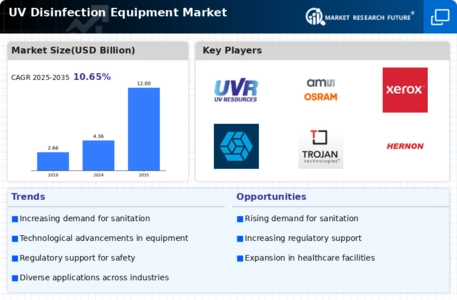Market Analysis
In-depth Analysis of UV Disinfection Equipment Market Industry Landscape
UV disinfection is proving to be a game-changer across various water disinfection applications, offering distinct advantages over traditional methods like chlorination. Safety concerns related to chlorination, coupled with advancements in UV technology, have spurred its acceptance in both municipal and household water treatment systems. UV light has demonstrated remarkable efficacy in eliminating an extensive array of microorganisms, including bacteria, viruses, protozoa, and certain pathogens that chlorine fails to neutralize. Notably, UV treatment successfully tackles chlorine-resistant protozoa like Cryptosporidium and Giardia, which are notorious for their resilience to standard disinfection methods.
The sterilizing power of ultraviolet rays is instrumental in inactivating these challenging pathogens, ensuring the elimination of waterborne diseases. This technology finds extensive global application in various sectors, encompassing wastewater treatment plants, water reclamation initiatives, drinking water treatment facilities, aquaculture, pool and spa maintenance, and ballast water treatment systems. The widespread adoption of UV disinfection in these sectors is a response to mounting concerns arising from pollution, climate change, evolving water consumption habits, and rapid urbanization, collectively escalating water stress levels.
For instance, in China, approximately 280 million people are compelled to consume contaminated drinking water daily due to the scarcity of potable water, dense population, and depleting clean water resources. Moreover, industries and agriculture currently consume about 70% of freshwater resources, contributing significantly to the amplified water stress levels. Consequently, the rising demand for safe water is compelling the implementation of advanced water and wastewater treatment technologies. This surge in demand is expected to notably boost the adoption of UV disinfection equipment for water and wastewater treatment applications. UV disinfection emerges as a critical technology to address these challenges, ensuring the delivery of safe, potable water and mitigating the impact of waterborne diseases, particularly in regions grappling with water scarcity and contamination issues.
Surface disinfection holds a pivotal role in various sectors, including healthcare, food and beverage industries, and households, as a cornerstone of infection prevention and control strategies. The imperative to control the transmission of infectious diseases, particularly during outbreaks like the COVID-19 pandemic, has escalated the utilization of disinfectants on a global scale. The widespread adoption of disinfection measures has been observed in diverse settings, ranging from public facilities, transportation systems, hospitals, and nursing homes to wastewater treatment facilities and individual households.
In the context of the ongoing global health crisis, the COVID-19 pandemic, there has been an unprecedented surge in the demand for disinfection products, propelled by the need to curtail the virus's spread. UV light has emerged as a proven and effective method for surface sterilization, demonstrating remarkable efficacy in eliminating drug-resistant superbugs and the novel coronavirus. The heightened efficacy of UV disinfection in mitigating the burden of infectious agents, including the novel coronavirus, has fueled its adoption in various settings, including healthcare environments, where stringent infection control measures are paramount.
















Leave a Comment